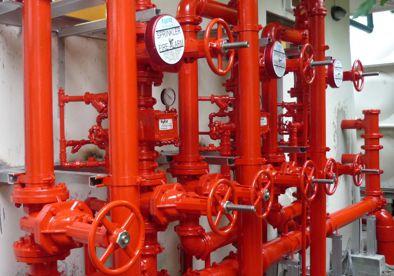Fire-fighting water supply

Fire–fighting water supply is one of the key elements of the fire safety system, ensuring effective fire extinguishing and minimizing fire damage. This system includes a complex of structures, equipment and engineering solutions aimed at delivering water to the fire site in the required volume and under the required pressure. The organization of fire-fighting water supply requires careful design, compliance with regulatory requirements and regular maintenance.
Key elements of fire-fighting water supply
Fire-fighting water supply is divided into two main types: external and internal. Outdoor water supply includes hydrants and reservoirs located outside buildings. The internal water supply, in turn, is represented by systems installed directly inside buildings, including fire taps, pumps, and water mains.
Fire hydrants are widely used for effective outdoor fire-fighting water supply. These devices are placed along roads and on the territory of facilities in such a way that fire trucks can easily approach them. The distance between the hydrants is usually 100-150 meters, which allows you to cover the entire facility in case of fire. Hydrants are connected to urban or autonomous water supply networks and provide high-pressure water supply.
Fire-fighting reservoirs or natural reservoirs such as rivers and lakes are also an important element of outdoor water supply. They are used in cases where there is no centralized water supply or its volume is insufficient to extinguish a large fire. Such reservoirs should be equipped with access roads and water intake devices so that fire departments can quickly begin to eliminate the fire.
Internal fire-fighting water supply systems are usually installed in residential, administrative and industrial buildings. These systems include a network of pipelines through which water is supplied to fire fighting cranes located on each floor of the building. Pumping stations are used to ensure constant pressure in the system, which automatically turn on when a fire occurs. Plumbing systems must always be in working order, which requires regular inspections and maintenance.
Modern fire-fighting water supply systems are often equipped with automatic sprinkler systems. Sprinklers are devices that activate when a certain temperature is reached and begin to spray water onto the fire. They allow you to quickly respond to fires and prevent their spread even before the arrival of firefighters. This approach significantly reduces the risk of large fires and minimizes damage.
The design of fire-fighting water supply systems is carried out taking into account the specifics of the facility and regulatory requirements. The main parameters that are taken into account include the area of the building, the number of floors, the purpose of the premises, as well as the risk of fires. Additional solutions may be required for large industrial facilities, warehouses, and shopping malls, such as the creation of independent water storage tanks and the installation of powerful pumps.
The role of regular maintenance in the effective operation of systems
Maintenance of fire-fighting water supply systems is an integral part of ensuring their reliable operation. Regular inspections of hydrants, pumps, pipelines, and sprinklers make it possible to identify and fix malfunctions at an early stage. In addition, training of personnel and fire services should be conducted so that all participants in the system are ready to act promptly in case of an emergency.
Compliance with regulatory requirements plays an important role in the organization of fire-fighting water supply. In Uzbekistan, this area is regulated by a number of standards and regulations, including standards for the design and operation of systems. Failure to comply with these requirements may result in fines, and in the event of a fire, significant material and human losses.
Fire–fighting water supply is a vital system on which the safety of people and the safety of property depend. Its proper design, installation and maintenance make it possible to effectively fight fires, reducing the risk of their spread and minimizing the consequences. Each facility must be equipped with a system that meets its characteristics and legal requirements to ensure maximum protection in the event of an emergency.
| Order installation or maintenance